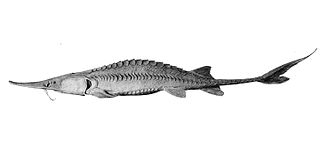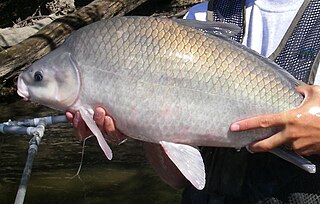
The white bass, silver bass, or sand bass is a freshwater fish of the temperate bass family Moronidae. commonly around 12-15 inches long. The species' main color is silver-white to pale green. Its back is dark, with white sides and belly, and with narrow dark stripes running lengthwise on its sides. It has large, rough scales and two dorsal fins. They are widely distributed across North America, inhabiting large reservoirs and rivers. When mating in the spring, they are more often found in shallow rivers, creeks, and streams. They have been introduced in some places as sport fish and also to predate on nuisance fish, such as gizzard shad. It is the state fish of Oklahoma.

The walleye, also called the yellow pike or yellow pikeperch or yellow pickerel, is a freshwater perciform fish native to most of Canada and to the Northern United States. It is a North American close relative of the European zander, also known as the pikeperch. The walleye is sometimes called the yellow walleye to distinguish it from the blue walleye, which is a color morph that was once found in the southern Ontario and Quebec regions, but is now presumed extinct. However, recent genetic analysis of a preserved (frozen) 'blue walleye' sample suggests that the blue and yellow walleye were simply phenotypes within the same species and do not merit separate taxonomic classification.

The bull trout is a char of the family Salmonidae native to northwestern North America. Historically, S. confluentus has been known as the "Dolly Varden", but was reclassified as a separate species in 1980. Populations of bull trout in the lower 48 states are listed as threatened under the U.S. Endangered Species Act, and bull trout overall are listed as vulnerable to extinction on the IUCN Red List of Threatened Species. The Saskatchewan-Nelson Rivers population in Alberta, Canada is listed as threatened under the Species at Risk Act.

The chain pickerel is a species of freshwater fish in the pike family of order Esociformes. The chain pickerel and the American pickerel belong to the Esox genus of pike.

The yellow perch, commonly referred to as perch, striped perch or preacher is a freshwater perciform fish native to much of North America. The yellow perch was described in 1814 by Samuel Latham Mitchill from New York. It is closely related, and morphologically similar to the European perch ; and is sometimes considered a subspecies of its European counterpart.

The cutthroat trout(Oncorhynchus clarkii) is a fish species of the family Salmonidae native to cold-water tributaries of the Pacific Ocean, Rocky Mountains, and Great Basin in North America. As a member of the genus Oncorhynchus, it is one of the Pacific trout, a group that includes the widely distributed rainbow trout. Cutthroat trout are popular gamefish, especially among anglers who enjoy fly fishing. The common name "cutthroat" refers to the distinctive red coloration on the underside of the lower jaw. The specific name clarkii was given to honor explorer William Clark, coleader of the Lewis and Clark Expedition.

Tailwater refers to waters located immediately downstream from a hydraulic structure, such as a dam, spillway, bridge or culvert. Generally measured and reported as the average water depth downstream of a hydraulic structure, tailwater can vary based on the outlet from the structure as well as downstream influences that may restrict or advance the usual flow of water from the structure. The creation of a tailwater will have significant impacts on both the abiotic and biotic conditions of the waterway.

Bowfishing is a fishing technique that uses specialized archery equipment to impale and retrieve fish. A bowfisher will use a bow or crossbow to shoot fish through the water surface with a barbed arrow tethered to a line, and then manually retrieve the line and arrow back, in modern times usually with a reel mounted on the bow. Unlike other popular forms of fishing where baiting and exploiting the fish's instinctual behaviors are important, bowfishing is similar to spearfishing and relies purely on the fisherman's own visual perception and marksmanship, and usually do not involve using other tools such as hand net.

Wabamun Lake is one of the most heavily used lakes in Alberta, Canada. It lies 65 kilometres (40 mi) west of Edmonton. It is 19.2 kilometres (11.9 mi) long and 6.6 kilometres (4.1 mi) wide, covers 82 square kilometres (32 sq mi) and is 11 metres (36 ft) at its deepest, with somewhat clear water.

The pallid sturgeon is an endangered species of ray-finned fish, endemic to the waters of the Missouri and lower Mississippi river basins of the United States. It may have even reached the St. Croix River before colonization.

The black buffalo is a North American species of freshwater fish in the Catostomidae or sucker family. With a lifespan greater than 100 years it is among the longest-lived of freshwater fish species. Found in the Mississippi Basin and southern Great Lakes. It was first discovered in Canada in the western end of Lake Erie and has been reported from Boston Creek. The Tennessee distribution ranges from rivers and streams in the Cumberland Mountains, a few rivers in middle Tennessee, and in west Tennessee along the Mississippi River. The ecology of the species is quite similar to that of I. bubalus. I. niger has a ventrally positioned mouth, making the species’ diet benthic-oriented. It has a distinct shape that mocks I. bubalus and I. cyprinellus, considering it a hybrid between the two species.

The American gizzard shad, also known as the mud shad, is a member of the herring family of fish and is native to large swaths of fresh and brackish waters in the United States of America, as well as portions of Quebec, Canada, and Mexico. The adult has a deep body, with a silvery-green coloration above fading to plain silver below. The gizzard shad commonly resides in freshwater lakes, reservoirs, rivers, and streams but can also reside in brackish waters, as it does on the Atlantic coast of the United States. Their range is across most of the continental United States, although they typically go no further north than New York and no further west than New Mexico. They are a large part of many of the ecosystems they inhabit and can drive changes in phyto- and zooplankton, thereby indirectly affecting other planktivorous fishes. The gizzard shad has been widely used as a food source for game fish, with varied success in management and effectiveness.

Electrofishing is a fishing technique that uses direct current electricity flowing between a submerged cathode and anode. This affects the movements of nearby fish so that they swim toward the anode, where they can be caught or stunned.
Discards are the portion of a catch of fish which is not retained on board during commercial fishing operations and is returned, often dead or dying, to the sea. The practice of discarding is driven by economic and political factors; fish which are discarded are often unmarketable species, individuals which are below minimum landing sizes and catches of species which fishers are not allowed to land, for instance due to quota restrictions. Discards form part of the bycatch of a fishing operation, although bycatch includes marketable species caught unintentionally. Discarding can be highly variable in time and space as a consequence of changing economic, sociological, environmental and biological factors.
Eagle Lake trout, Oncorhynchus mykiss aquilarum, is a subspecies of rainbow trout endemic to Eagle Lake, in Lassen County, California. It is a type of trout known for its ability to withstand high alkalinity. Its unique adaptations to the harsh environment of Eagle Lake make the fish a specialist with a very narrow environmental specificity.

Canadian aquatic invasive species are all forms of life that traditionally has not been native to Canada's waterways. In Eastern Canada, non-native plant and animal species are a concern to biologists. Bringing non-native species such as invasive fishes into Canada can damage the environment and ecosystem by repressing native species due to food competition or preying. Invasive fishes enter the fresh waters of Canada in several ways including drifting, deliberate introduction, accidental release, experimental purposes and, most commonly, through the attachment on international boat hulls. Invasive species are the second biggest threat to fish and other marine life in Canada behind loss of habitat and degradation. The threat to native species is primarily caused by impacts on the food web; however, invasive species also bring dangerous pathogens and physically interfere with existing aquatic life. Invasive species include sea lampreys, zebra mussels, smallmouth bass, European green crab, vase tunicate, and sea squirts.

Ictiobus, also known as buffalofishes, buffalofish or simply buffalo, is a genus of freshwater fish native to North America, specifically the United States, Canada, Mexico, and Guatemala. They are the largest and longest-lived of the North American suckers, reaching up to 1.23 m (4.0 ft) in length and more than 100 years of age for three of the five species. At up to 127 years for bigmouth buffalo, they are the longest-lived freshwater teleost, which is a group of more than 12,000 species. Bigmouth buffalo, black buffalo and smallmouth buffalo are found in the United States or Canada. Little is known about the two other buffalofish species: the fleshylip buffalo found in Mexico, or the usumacinta buffalo found in Mexico and Guatemala. Buffalofish are not carp, nor is any other catostomid; they belong to different scientific families having evolved on separate continents. Buffalofish live in most types of freshwater bodies where panfish are found, such as ponds, creeks, rivers, and lakes. Ictiobus were caught by the Lewis and Clark Expedition.

The smallmouth buffalo is one of the longest-lived fishes, capable of living more than a century. They are a catostomid fish species native to the major tributaries and surrounding waters of the Mississippi River in the United States, as well as some other water systems where it has been introduced. It is a long-lived, stocky fish like its relatives the bigmouth buffalo and the black buffalo. The smallmouth buffalo's mouth is located ventrally like other Catostomidae species, whereas the bigmouth buffalo's mouth is terminal and opens forward. It is thought that smallmouth buffalo eyes are significantly larger than those of the black buffalo. Despite being members of different scientific families, these three species superficially resemble the common carp, but an easy and notable difference is that all catostomids lack the characteristic barbels of carp.
Ashley H. Moerke is an American ecologist and a professor at Lake Superior State University. Her research focuses on freshwater ecosystem management, especially around the Great Lakes. Moerke advises local and state governments and bi-national commissions on water science, fisheries, and other environmental issues. In 2020, she was chosen as president-elect of the Society for Freshwater Science.
Big Creek State Park is a 3550-acre state park located in Polk County, Iowa.